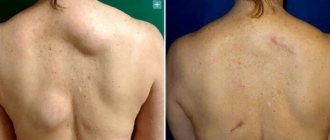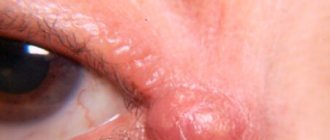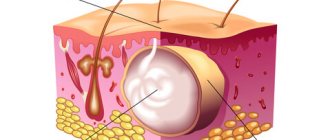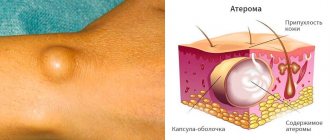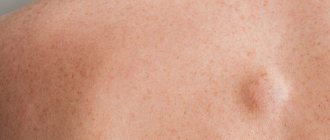The sebaceous glands are located deep in the skin, close to the hair follicles. Their function is to produce fatty lubricants for the skin and hair. If the duct of the sebaceous gland becomes clogged, a cyst filled with mushy sebum forms in its place. When the contents of the cyst become infected, inflammation and suppuration occur—purulent atheroma.
Atheromas can form anywhere on the human body where hair grows. Most often they occur on the scalp, face, neck, back and genitals.
What is atheroma
Despite the fact that the pathology looks similar to a skin tumor, it is a sebaceous cyst. The appearance of a lump is associated with a violation of the outflow of glandular secretions and its deposition under the skin layer. The secretion usually accumulates in the duct; it is not removed from the gland and makes its walls stretchable. The greasy contents gradually mix with dead organic substances, cholesterol inclusions, drops of fat, and dead keratinized epidermis. The inside of the neoplasm is lined with flat epithelium.
The structure of skin atheroma can be divided into several elements:
- cavity with contents;
- capsule;
- hole (does not always happen);
- leather;
- subcutaneous fat tissue.
The disease is equally common in men and women. It is a common pathology in skin appendage surgery. Most often, a lump is found on the head due to the presence of a large number of sebaceous glands there.
Complications of the disease
Suppurating atheromas lead to various complications: the development of an inflammatory process, the formation of phlegmon or an abscess.
Inflammation occurs when an infection enters the cavity of the cyst - it increases in size, becomes hyperemic and painful.
Phlegmon is a disease in which the purulent contents of the atheroma do not come out, but remain under the skin.
An abscess occurs when the capsule ruptures. There are cases when the disease took on an oncological character.
Causes of atheroma
The specific reason for the appearance of atheroma is the disruption of the sebaceous glands, but a number of predisposing factors lead to this. They are the ones who provoke problems with the separation of sebum, its increased production and blockage of the duct to the outside, which can lead to the appearance of skin atheroma. Factors in the development of the disease include:
- heredity;
- hormonal imbalance (especially in adolescence, when taking hormonal drugs, etc.);
- hyperhidrosis – increased sweating;
- untimely exfoliation of dead skin;
- high viscosity of sebum (individual feature);
- problems with excretory function;
- increased skin contamination;
- narrowness of the gland ducts;
- insufficient hygiene;
- chronic skin trauma;
- negative impact of the environment;
- the use of antiperspirants, which narrow the ducts and clog the gland.
How does inflammation occur?
Lipids accumulating in the cyst capsule provide a breeding ground for the proliferation of pathogenic microorganisms. After entering the atheroma cavity, they multiply and thereby trigger the inflammatory process.
Causes of infection:
- An attempt to get rid of atheroma on your own, to squeeze it out;
- Failure to comply with hygiene rules;
- Excessive production of testosterone by the body of a man or androgens by the body of a woman;
- The use of synthetic clothing and the resulting increased sweating;
- Injury to the epidermis in the projection of atheroma.
With weakened immunity, secondary infection can occur when pathogenic organisms penetrate the atheroma capsule through the bloodstream from other foci of infection.
Symptoms and localization
It is not difficult to recognize atheroma by visual examination; additional diagnostics, as a rule, are not required. It looks like a neoplasm located under the skin and comes in various sizes - from a button to a chicken egg. When palpated, the lump is dense, covered with skin, since it is fixed in the area of the gland and does not move freely during palpation. A black dot can be found on the surface - this is a clogged duct of the sebaceous gland. When pressed, fat masses come out.
When palpated, the neoplasm is dense and painless if there is no inflammatory process. Sometimes, in places where visibility is difficult, patients cannot even assume the presence of pathology. When the cyst is small, it does not cause discomfort, and its enlargement occurs quite slowly. For tumors 3–4 cm in diameter, the neoplasm causes discomfort and is a significant cosmetic defect. If we talk about the face, where the skin is thin, patients prefer to remove even small tumors up to 1 cm in diameter, since the lump becomes noticeable.
Atheroma is located in places where sebaceous glands accumulate, actively secreting secretions. Most often, a tumor appears in the head area, growing to large lumps. Skin atheromas are also diagnosed on the back between the shoulder blades, in the neck, on the face, near the tailbone and even on the genitals. They can become encysted with connective tissue, remaining the same painless bumps for a long time.
Symptoms of skin atheroma become more obvious if it suppurates. This usually happens with long-existing large tumors. Typical signs of an inflamed cyst:
- pain at the site of the tumor;
- redness and local hyperthermia;
- subcutaneous abscess;
- swelling of the skin;
- increased body temperature;
- involvement of surrounding structures, such as lymph nodes, in the inflammatory process.
Atheroma during inflammation can open on its own, especially if there was a blocked duct. Purulent discharge and the contents of the gland are released through it. It is better to remove the cyst in a timely manner so as not to worsen the situation. The transformation of pathology into a malignant neoplasm occurs extremely rarely.
Characteristic symptoms of cyst suppuration
Inflamed atheroma may not cause any discomfort at first. If you do not seek help in time, local symptoms appear, and then the general condition of the body worsens.
Local symptoms:
- Education is painful;
- Rapid increase in size;
- Redness of the skin over the cyst;
- Twitching sensations at the site of the cyst, due to suppuration of its contents;
To make a diagnosis, the surgeon will rely on external data obtained from examination and palpation of the formation. It is important not only to seek treatment early, but also to choose a qualified specialist. At our clinic you can get all the help you need.
Useful information about visiting a surgeon at the clinic:
- How to prepare for a surgeon's appointment
- What diseases does the surgeon treat?
- Calling a surgeon to your home
- Surgical care in the clinic
- Surgical care at home
- What symptoms should you contact a surgeon for?
- Treatment of surgical diseases
- Treatment of intestinal pathologies
- Treatment of skin surgical pathologies
- Treatment of bedsores and necrosis
- Treatment of parasitic diseases
- Treatment of inflammatory processes of soft tissues
- Treatment of diseases of the musculoskeletal system
- Diagnosis of surgical diseases
Treatment
Treatment of skin atheroma is not required if it is small in size and not inflamed. In this case, it is enough to observe the neoplasm. As the size of the tumor increases, if it causes discomfort and is a cosmetic defect, it is removed surgically. Surgery is performed under local anesthesia. There is no conservative treatment for the disease.
The intervention is performed in a clinic and does not require hospitalization if the skin atheroma is small and located in a place convenient for the intervention. The tumor is excised along with the capsule, as this gives a better effect and reduces the risk of relapse in the same place. An uncomplicated tumor is operated on in one of the following ways:
- an incision is made at the site of the neoplasm in its center, the contents are removed, and then the capsule is excised;
- an incision is made along the edge, the cyst is moved along with the intact capsule and removed with a surgical spoon;
- enucleation using two incisions and jaws, which remove the neoplasm along with the capsule.
The latter method of surgical intervention is the most effective. After removal, self-absorbing internal sutures and atraumatic thread sutures are applied, which must be removed after a week.
Types of purulent atheromas
The cyst begins to become inflamed in the case of a long course of the disease and occurs in a septic or aseptic way. Inflammation becomes aseptic when the cyst capsule is irritated by the underlying tissues. This is possible when clothing rubs against the formation or puts pressure on it from the outside. The atheroma swells, sometimes pain appears. After a few days, all symptoms subside, and connective tissue forms around the formation. It envelops the atheroma like a shell.
Septic inflammation is recorded more often than aseptic inflammation. The reason is the penetration of infection into the cyst. Symptoms are more clear. Characterized by constant pain in the area of the cyst and redness. Due to the suppuration of the secretion in the atheroma, the local temperature rises, and then the general one. The outcome of such inflammation can be different: from the cyst breaking out or the capsule melting and turning into phlegmon.
What symptoms do you see a surgeon for:
- Presence of hernial protrusion
- Daggering pains in the abdomen
- Bloating
- Pain in the right hypochondrium
- Bitterness in the mouth
- Nausea
- Presence of neoplasms on the skin
- Swelling and redness of the skin
- Bone fractures and bruises
- Wounds of any location
- Vomit
- Enlarged and painful lymph nodes
Prevention
There are no effective methods of prevention. If there is increased secretion of the sebaceous glands, atheromas may appear in places near removed bumps or in new locations. As a preventative measure, you can eat less fatty and high-carbohydrate foods so as not to stimulate the glandular apparatus. Use antiperspirants as little as possible; your skin is oily. Use the right skincare products for your skin type to ensure that your pores are free of sebum.
Forecast for the development of a festering cyst
To put it figuratively, any atheroma, even if it is small in size, is a kind of “time bomb”.
Any injury can damage the epidermis, and then the progressive inflammatory process produces the following complications:
- Abscess;
- Cellulitis, forming diffuse inflammation under the skin;
- Blood clot formation is a possible cause of death.
This means that at the first signs of atheroma inflammation, you should consult a doctor. This could be a surgeon, dermatologist.
The appearance of atheroma, why does this happen?
Among the causes of atheroma, there are several main ones:
- insufficient skin care - with prolonged accumulation of dirt particles mixed with sweat in the thickness of the skin, blockage of the glandular duct is possible, which leads to the formation of atheroma;
- systematic injury to the skin - causes detachment of skin cells that prevent the outflow of glandular secretions;
- hormonal imbalance – this especially applies to sex hormones;
- excessive sweating;
- poor environmental situation.
Rice. 3. Squeezing out atheroma is not recommended.
How is the procedure done?
The procedure for removing lipoma, hygroma, atheroma, fibroma and wen is a surgical excision of the affected area with the application of an intradermal cosmetic suture. Subcutaneous formations up to 10 cm are removed on an outpatient basis, without hospitalization, under local anesthesia. The procedure takes about 20 minutes. If the tumor is located in a hard-to-reach area near large blood vessels or nerve branches, intravenous anesthesia is possible. After opening the lipoma, hygroma, atheroma, fibroma and wen, their contents are sent to the laboratory for histological examination.
Indications for surgery:
- Big sizes
- Fast growth
- Inflammation, pain, swelling, suppuration, redness
- Physical discomfort
- Cosmetic defect
Classification
The cellular structure of atheromas is different. Since this does not manifest itself clinically, the histological classification is practically not used and is of interest only to researchers. The more common classification is based on the mechanism of formation of sebaceous gland cysts:
- True or primary. These are congenital formations that are formed at the stage of intrauterine development of the fetus. It is usually diagnosed in children from the moment of birth. Often the formations are multiple in nature and rarely exceed 5 mm in diameter. Mostly located in the perineal area.
- False or secondary. They occur mainly in adults as a result of blockage of the duct of unchanged sebaceous glands. Over time, the cyst gradually increases and can reach 10 cm in diameter. Localization of false atheromas is most often observed on the head, neck and upper back.
Is it possible to open atheroma and treat it at home?
Traditional methods of treatment against atheroma are ineffective. Local exposure using herbal decoctions and alcohol infusions is not effective; it will not help empty the cyst and eliminate the capsule, which becomes a source of re-development of the formation.
You cannot open the atheroma yourself at home. It is impossible to provide a sufficient level of asepsis and sterile surgical instruments outside the conditions of a medical institution. Treatment under such conditions can lead to infection and the development of complications. Atheroma will result in the formation of an abscess or phlegmon. It is especially dangerous if you open an atheroma on the face or head.
Where to remove lipomas, atheromas, hygromas, fibromas, wen and boils in Moscow?
In a multidisciplinary medical center you can always remove lipomas, atheromas, hygromas, fibromas, wen and boils
. Our medical center is located between the Konkovo and Belyaevo metro stations (South-Western Administrative District of Moscow in the area of the Belyaevo, Konkovo, Teply Stan, Chertanovo, Yasenevo, Sevastopolskaya, New Cheryomushki metro stations " and "Trade Union"). Here you will find highly qualified personnel and the most modern diagnostic equipment. Our clients will be pleasantly surprised by our quite affordable prices.
